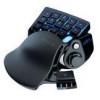Belkin n52te User Manual - Page 3
Creating a Profile, Remapping Single-Key Assignments, Keymap, MACROS, Available Macros, Delete, - software
 |
UPC - 722868643150
View all Belkin n52te manuals
Add to My Manuals
Save this manual to your list of manuals |
Page 3 highlights
Creating a Profile This section will explain how to create a profile using the n52te Editor software. In general, creating a profile consists of remapping button functions for each of the three Keymaps, configuring Auto-Switching options, and naming and saving your profile. 1. Click on the "New Profile" button. 2. Locate and open the application executable to which you wish to program the new profile. 3. Your new profile has been created. Proceed to the next section to learn how to customize and program your new profile. MACROS Macros are recorded sequences of keyboard keystrokes, and/or mouse-button presses that can be saved and played back by the n52te at a later time. The "Macros" pane allows you create, edit, and manage macros. Saved macros can then be assigned to any button in any of the three Keymaps, and are available for use in any profile. Remapping Single-Key Assignments 1. Begin from the "Profiles" pane. 2. For the n52te button you wish to program, locate and select it from the buttons list. 3. Under "Assignment:", select "Single Key" from the drop-down menu. Then, press a key on your keyboard and it will be recorded by the Editor software. When a key is assigned to a button, pushing the button is the same as pressing that key on the keyboard. 4. If you are happy with the current assignment, you can continue to program other buttons in the same manner or close out of the n52te Editor software to immediately use your newly programmed profile. Keymap The n52te Editor allows you to program three Keymaps: Blue, Red, and Green. A Keymap allows you to add another layer of programming to each button. In order to switch between Keymaps during play, you must either dedicate a button for switching to the desired Keymap, or dedicate one to cycle through all three Keymaps. Because the second option of cycling through Keymaps requires only one button, two extra buttons are free for further customization. Note: Buttons that are selected for one of these Keymap switching options will be dedicated to this function across all three Keymaps in the current profile. Available Macros - This displays a list of existing macros currently stored on your Mac computer. New - This button is used to create a new macro. Delete - This button is used to delete any existing macro. Import - This button allows you to import a macro from a backup or from a different Mac computer. Export - This button allows you to back up your macros or use on a different Mac computer. • To program Keymap switching options, locate the desired n52te button from the "Profiles" pane, and then from the "Assignment" drop-down menu, select "Keymap". The default switching option is "Cycle Keymaps". To choose a different one, select from the options available under the drop-down menu. Note: You cannot record mouse-click commands and advanced functions during the macro-recording phase, but you can add them manually by using "Add Button". • If you select "Momentary", the n52te will only load the desired Keymap while you hold that button down. If you select "Toggle", the button acts like a switch and n52te will remain in the desired Keymap until another Keymap is selected. • You can view and edit different Keymaps by selecting "Blue", "Red", or "Green" under the "Keymap" drop-down menu. Page 3









